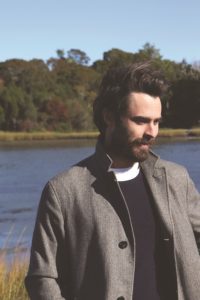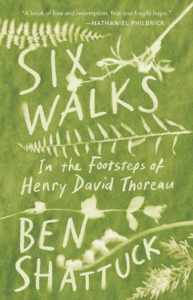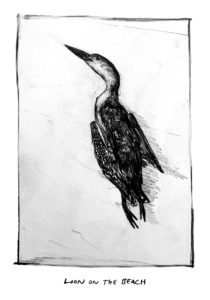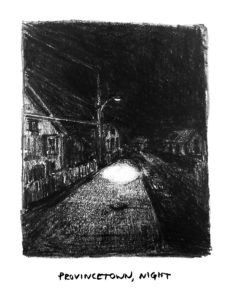August is a poet with a fellowship in the White Mountains of New Hampshire. He’s lonely. The intoxication of procrastination and the cold fingers of autumn poking into his cabin lead him to spend more time at a nearby slate mining museum than he does writing. To be fair, the museum has a working furnace; his cabin does not.

That’s how August stumbles on the historical evidence: a century earlier, 13 loggers died in the woods nearby. The case was never solved, but a newspaper clipping suggests that one of the men left behind a journal.
Like a word on the tip of your tongue, the question of what happened to the loggers propels “August in the Woods,” the sixth story in Ben Shattuck’s new collection, The History of Sound. A field trip to the mysterious death site accompanied by his childhood best friend who is visiting from Laos and the E.R. doctor who recently dumped him proves to be a revelation for August’s writing and his life — but does nothing to solve the cold case.
That catharsis comes in the seventh story, “The Journal of Thomas Thurber,” set a hundred years in the past. The journal entries detail a Lord of the Flies-esque social collapse over three winter months.
Each of the 12 stories in the book has a twin that’s set in a separate era at some point between 1696 and the present. The collection is structured as a hook and chain, a poetic form popularized in 18th-century New England that follows this rhyming pattern: A BB CC DD EE FF A.
“The second half of the couplet,” Shattuck explains in an epigraph, “often completes the sentence or sentiment of the first.”
The four other nested pairs in The History of Sound present a narrative followed by a companion piece that excavates an object mentioned in the first: a painting of a songbird, a grafted apple tree, the extinct great auk, a charlatan’s bible. These objects are not necessarily the focus of the stories but rather the throughlines.
Like Thomas Thurber’s journal, they continue to exist despite being out of the sight of the characters who first ascribed meaning to them. Emotions are archived within each of them. This concept isn’t novel, but with the hook-and-chain form, Shattuck’s execution is.
His archeological impulse in tracing the meaning of objects across time is present in the stories bookending the collection. The titular story, which opens the book, details a brief but defining love affair between Lionel and David, two New England Conservatory students who meet as young men in a Boston bar in 1917. (A film adaptation starring Paul Mescal and Josh O’Connor is in the works.)
After David leaves to serve in World War I, Lionel, who has a medical exemption, returns to his family’s Kentucky farm, anticipating the righting of the world — and word from David.
“I thought of him in the way you do when you’re young,” muses Lionel. “In the mornings, lying in bed listening to the songbirds, sheets tangled around my legs; when I stood in the kitchen watching the kettle, waiting for it to boil; when I was pruning, grafting, stalking, and guying the fruit trees; after work, walking to the streambed and listening to the spring peepers; sitting on the porch, listening to a thunderstorm clear its throat on the horizon in three notes, the smell of dirt released under the storm’s coming. As in, always.”

There is a multi-layered acknowledgment of how love, the predominating emotional force in all 12 stories, is the ultimate projection. The receiving object is not just the person. It is also every experience had and every object held since the transfiguration of a stranger or friend into the beloved.
After the war, Lionel and David reunite for a summer to walk hundreds of miles in the woods of Maine collecting folk songs, which they record on 25 wax phonograph cylinders. September 1919 is the last time they see each other, and the cylinders seem to disappear.
More than 60 years later, in the last story, “Origin Stories,” a woman named Annie finds them in a secret cache under the floor of the home she shares with her husband and first love, a professor at Bowdoin College. She sends them back to Lionel, now 84, and the discovery — tied to the thought that other people have lived more interesting lives than hers — prompts a total reevaluation of the role love has played in hers.
Both stories ask: is love the beginning or the end?
Like all literature that finds you exactly when you need it, Shattuck’s book becomes the first half of a couplet that hooks to a second half composed of the reader’s experience. Each story irrevocably links the physical book to the memories, emotions, and places experienced as it was read.
This reader’s copy, speckled with grains of Herring Cove sand and spilled coffee and the fingersprints of someone she doesn’t want to say goodbye to, is an object in which the community and revelation of a first summer in Provincetown will continue to exist, whether this September or 60 from now.
Shattuck, who with his brother runs the general store in Dartmouth, his hometown, will be talking about writing with Michael Cunningham at the Fine Arts Work Center at 6 p.m. on Friday, Aug. 23.
Hook and Chain
The event: Ben Shattuck and Michael Cunningham in conversation
The time: Friday, Aug. 23, 6 p.m.
The place: Fine Arts Work Center, 24 Pearl St., Provincetown
The cost: Sliding scale, free to $65





